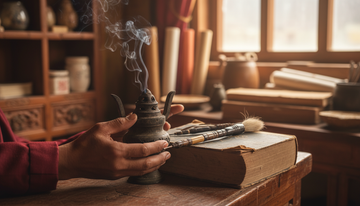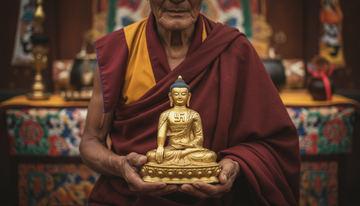On a rainy afternoon or a quiet evening, you light a stick of incense. You watch the wisp of smoke curl upwards, and as the calming fragrance fills the air, the rhythm of the world seems to slow down.
This simple, therapeutic act is, in fact, part of a beautiful tradition that stretches back thousands of years.
That little stick of incense in your hand has a rich past. It once served as an offering in solemn temples and was savored by scholars and poets in their quiet studies. Its story is a journey from sacred ritual to a cherished part of our modern lives—a brief history of the Way of Incense.
At zensoullab, we are completely captivated by this history. It’s a gentle reminder that beauty and tranquility aren't distant ideals, but can be found right here, in the space of a single breath.
The Beginning: A Bridge to the Divine
In its earliest days, incense was a precious and sacred substance.
In ancient China, people believed that the smoke from burning incense could ascend to the heavens, acting as a bridge to communicate with deities and ancestors. Burning incense was therefore an essential part of major ceremonies, from worship to prayer. The incense of that era carried people's most reverent and sincere hopes. It was a medium, connecting the human world to the timeless and divine.
The Song Dynasty: An Art for the Soul
If the first chapter of incense was about reverence, the Song Dynasty (960–1279 CE) was about appreciation.
This was an era when the aesthetics of daily life were elevated to an art form. Chinese scholar-officials considered "savoring incense" (xiangdao) one of the four great arts of living, alongside preparing tea, arranging flowers, and creating paintings. Incense was no longer confined to religious rituals; it found a new home in the intimate spaces of studies, studios, and social gatherings.
These scholars were not content to simply burn incense. They delved into the art of blending different aromatic ingredients, experimented with ways to appreciate their scents, and contemplated the moods each fragrance evoked. Incense became a "soulmate" that calmed their minds, nurtured their character, and inspired their creativity. It had gracefully moved from the altar to the scholar's desk.
The Journey to Japan: The Birth of Kodo
This refined culture of incense appreciation traveled from China to Japan, where it merged with the unique aesthetics of Zen Buddhism and Japanese ritual. There, it evolved into an incredibly sophisticated and disciplined art form known as Kodo, the "Way of the Incense."
In Kodo, one does not merely "smell" incense; one "listens" to it. It is a formal ceremony with a precise set of rules and specialized utensils. Participants must cultivate a state of deep concentration and respect to discern the subtle nuances of fragrance released by aromatic woods at different temperatures. It is a true spiritual practice, a form of meditation that uses the sense of smell to achieve a state of heightened awareness.
Returning to Now: An Aesthetic for Our Lives
So, is the Way of Incense a distant, inaccessible art form for us today?
Not at all.
For me, the most beautiful part of this evolution is how it has come full circle, returning to the simplicity of our personal lives. We don't need elaborate ceremonies or to be seasoned poets. All we need is a quiet corner, a burner that we love, and a stick of incense that helps us unwind.
At zensoullab, we believe this simple act is, in itself, a modern form of "the art of living."
It's a small ritual that allows you to step away from your busy schedule, even if just for five minutes. It's an act of self-care, using a beautiful scent to clear the dust from your mind. And it's a reminder that no matter how chaotic the world gets, we always have the power to create a small, fragrant sanctuary for ourselves.
From a bridge to the gods, to a poet's companion, to the stick of incense in your hand today—the story of incense is really the story of our own timeless search for peace and beauty in our lives.













